简单分析一下商品分类表的结构
先来说一下分类表与品牌表之间的关系
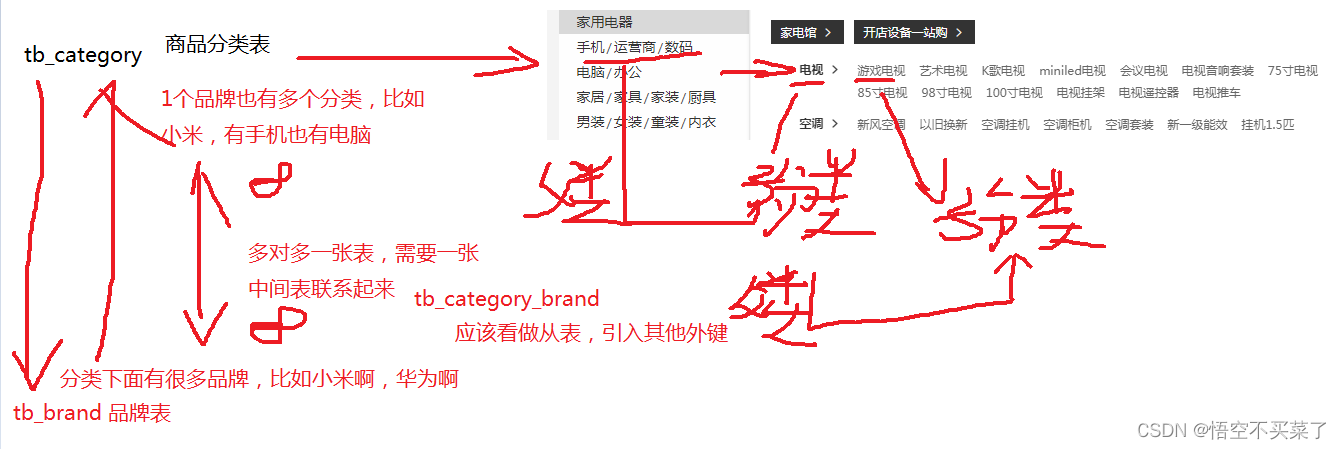
再来说一下分类表和品牌表与商品表之间的关系

面我们要开始就要创建sql语句了嘛,这里我们分析一下字段
用到的数据库是heima->tb_category这个表

现在去数据库里面创建好这张表

下面我们再去编写一个实体类之前,我们去看一下这个类的请求方式,请求路径,请求参数,返回数据都是什么
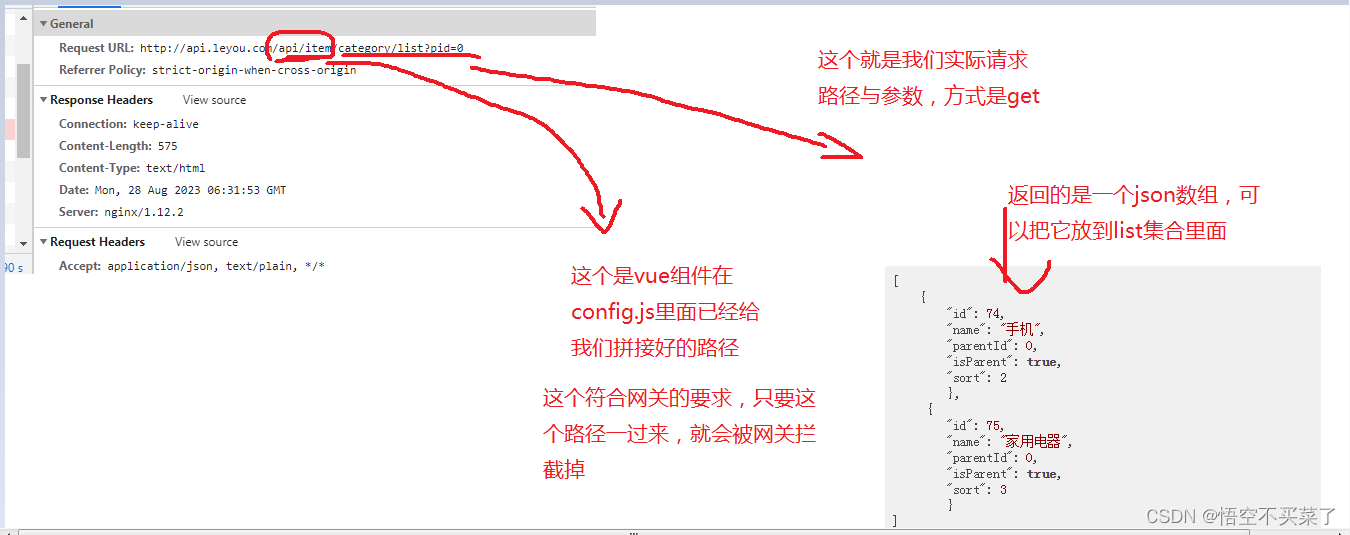
下面再去编写实体类
实体都是放到

出现了一个小插曲,开始的时候,我maven项目右边的模块有些是灰色的,导致我导入依赖之后,所有的注解什么都不能用,解决方案如下

然后把依赖重新导入一下
我们先去完成我们商品分类表的一个实体类

Category.java
package com.leyou.item.pojo;
import lombok.Data;
import tk.mybatis.mapper.annotation.KeySql;
import javax.persistence.Id;
import javax.persistence.Table;
/**
* Created by Administrator on 2023/8/28.
*/
@Table(name="tb_category")
@Data
public class Category {
@Id
@KeySql(useGeneratedKeys = true)
private Long id;
private String name;
private Long parentId;
private Boolean isParent;
private Integer sort;
}
然后去到ly-item-service去写具体的业务逻辑,比如mapper,service,web都在这里面
这里来说一个依赖问题

引入了spring-boot-starter-web这个依赖,也包含了spring的核心依赖
说一下在写这个controller类的时候,我们的路径是什么,路径就是我们访问每一个接口传递过来的url
ResponseEntity这个类是干嘛的
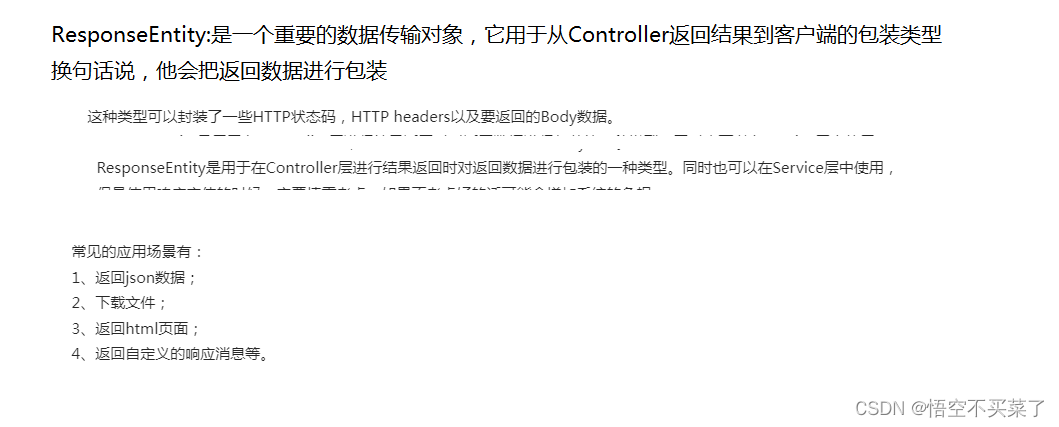
 格式用法有两种
格式用法有两种

CollectionUtils工具类
这个是Spring给我们提供的一个工具类
我们可以来做如下检测

 下面我们贴上这个CategoryController的代码
下面我们贴上这个CategoryController的代码
package com.leyou.item.web;
import com.leyou.item.pojo.Category;
import com.leyou.item.service.CategoryService;
import org.springframework.beans.factory.annotation.Autowired;
import org.springframework.http.HttpStatus;
import org.springframework.http.ResponseEntity;
import org.springframework.util.CollectionUtils;
import org.springframework.web.bind.annotation.GetMapping;
import org.springframework.web.bind.annotation.RequestMapping;
import org.springframework.web.bind.annotation.RequestParam;
import org.springframework.web.bind.annotation.RestController;
import java.util.List;
/**
* Created by Administrator on 2023/8/29.
*/
@RestController
@RequestMapping("/category")
public class CategoryController {
@Autowired
private CategoryService categoryService;
/**
* 根据父节点的id查询商品分类
* @param pid
* @return
*/
@GetMapping("/list")
public ResponseEntity<List<Category>> queryCategoryListByPid(@RequestParam("pid")Long pid) {
try {
if(pid == null || pid.longValue() < 0) {
//会返回带着状态码的对象400 参数不合法
// return ResponseEntity.status(HttpStatus.BAD_REQUEST).build();
//可以做一格优化,下面的类似
return ResponseEntity.badRequest().build();
}
//开始利用service执行查询操作
List<Category> categoryList = categoryService.queryCategoryListByParentId(pid);
if(CollectionUtils.isEmpty(categoryList)) {
//如果结果集为空,响应404
return ResponseEntity.notFound().build();
}
//查询成功,响应200
return ResponseEntity.ok(categoryList);//这里才真正放了数据
} catch (Exception e) {
e.printStackTrace();
}
//自定义状态码,然后返回
//500返回一个服务器内部的错误
//这里也可以不返回,程序出错,本身就会返回500
return ResponseEntity.status(HttpStatus.INTERNAL_SERVER_ERROR).build()
}
}
下面我们去Service创建queryCategoryListByParentId这个方法
看一下完整代码
package com.leyou.item.service;
import com.leyou.item.mapper.CategoryMapper;
import com.leyou.item.pojo.Category;
import org.springframework.beans.factory.annotation.Autowired;
import org.springframework.stereotype.Service;
import java.util.List;
/**
* Created by Administrator on 2023/8/29.
*/
@Service
public class CategoryService {
@Autowired
private CategoryMapper categoryMapper;
/**
* 根据父节点的id来查询子结点
* @param pid
* @return
*/
public List<Category> queryCategoryListByParentId(Long pid) {
Category category = new Category();
category.setParentId(pid);
return categoryMapper.select(category);
}
}
上面都做完了,现在去数据库操作把分类中的数据给插入一下,类似于如下这些数据

下面就是在数据中存在的数据
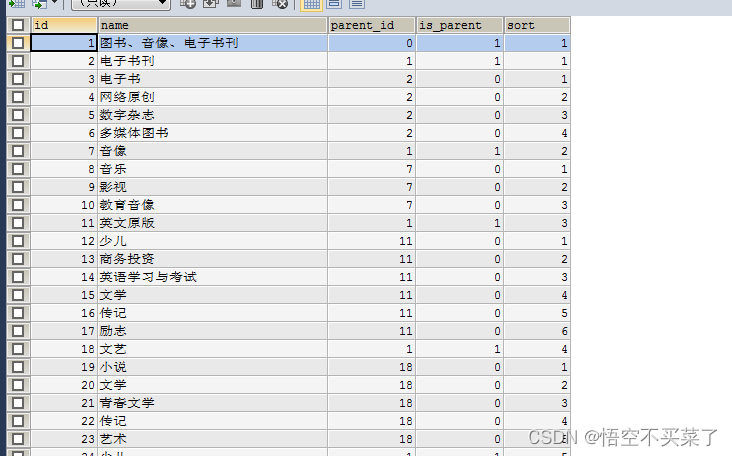
下面我开始去启动:
我们的数据肯定是去走网关的
 网关很明显我们是可以看到数据的
网关很明显我们是可以看到数据的
但是在项目里面点击就出不来

上面明显就是出现了跨域的问题

![]()
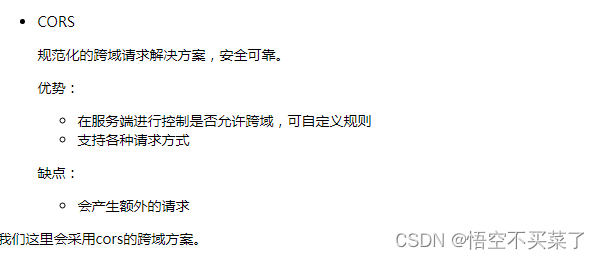
跨域我们就是在服务端进行一个配置

说的简单点,服务器就给给我们配置如下信息

我们这里在服务器搭配一个类来配置这些信息就可以了
我们这里用SpringMVC帮我们写的一个cors跨域过滤器来做:CrosFilter
具体代码如下
package com.leyou.config;
import org.springframework.context.annotation.Bean;
import org.springframework.context.annotation.Configuration;
import org.springframework.web.cors.CorsConfiguration;
import org.springframework.web.cors.UrlBasedCorsConfigurationSource;
import org.springframework.web.filter.CorsFilter;
/**
* Created by Administrator on 2023/8/31.
*/
@Configuration
public class LeyouCorsConfiguration {
@Bean
public CorsFilter corsFilter() {
//1.添加CORS配置信息
CorsConfiguration config = new CorsConfiguration();
//1) 允许的域,不要写*,否则cookie就无法使用了
config.addAllowedOrigin("http://manage.leyou.com");
config.addAllowedOrigin("http://www.leyou.com");
//2) 是否发送Cookie信息
config.setAllowCredentials(true);
//3) 允许的请求方式
config.addAllowedMethod("OPTIONS");
config.addAllowedMethod("HEAD");
config.addAllowedMethod("GET");
config.addAllowedMethod("PUT");
config.addAllowedMethod("POST");
config.addAllowedMethod("DELETE");
config.addAllowedMethod("PATCH");
// 4)允许的头信息
config.addAllowedHeader("*");
//2.添加映射路径,我们拦截一切请求
UrlBasedCorsConfigurationSource configSource = new UrlBasedCorsConfigurationSource();
configSource.registerCorsConfiguration("/**", config);
//3.返回新的CorsFilter.
return new CorsFilter(configSource);
}
}
重新启动一下网关服务器

下面来讲品牌查询

我们现在要做的就是查询出上面的品牌
我们必须弄明白请求方式,请求路径,请求参数,响应数据决定返回值
一般来说如果页面要展示一个列表的话,就要返回一个List集合对象或者返回一个分页对象
我们就必须定义一个分页对象
分页对象后面大家都要用,我们就放到common里面去
先来把这个分页对象给做了
package com.leyou.common.pojo;
import lombok.AllArgsConstructor;
import lombok.Data;
import lombok.NoArgsConstructor;
import java.util.List;
/**
* Created by Administrator on 2023/9/2.
*/
@Data
@NoArgsConstructor
@AllArgsConstructor
public class PageResult<T> {
private Long total;//总条数
private Integer totalPage;//总页数
private List<T> items;//当前页面数据对象
public PageResult(Long total,List<T> items) {
this.total = total;
this.items = items;
}
}
下面我们来做一下前端页面
先去找这个页面,在menu.js里面,去查看商品的路径在什么位置
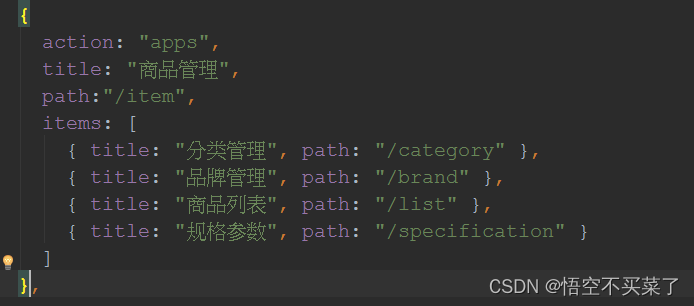
上面就是品牌的路径/item/brand,下面我们看组件在哪里
去到下面这个位置

这个位置去找我们的路由页面


所有的页面组件全部都在pages里面放着
我们这里自己来写一下组件
我们自己定义一个MyBrand1.vue组件
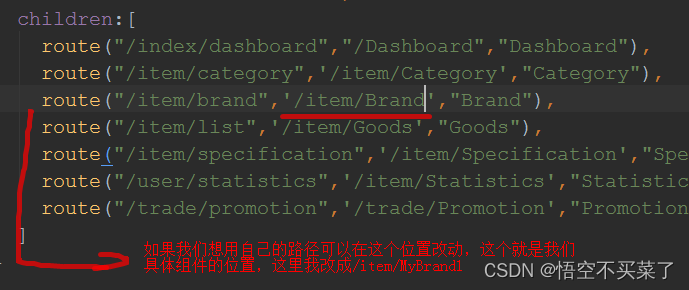

我们这个页面主要还是去做一个分页的表格
可以去Vuetify里面查找
我们这里应该去找从服务端就已经分页与排序好的数据

下面我们可以去看到这里面的模板代码
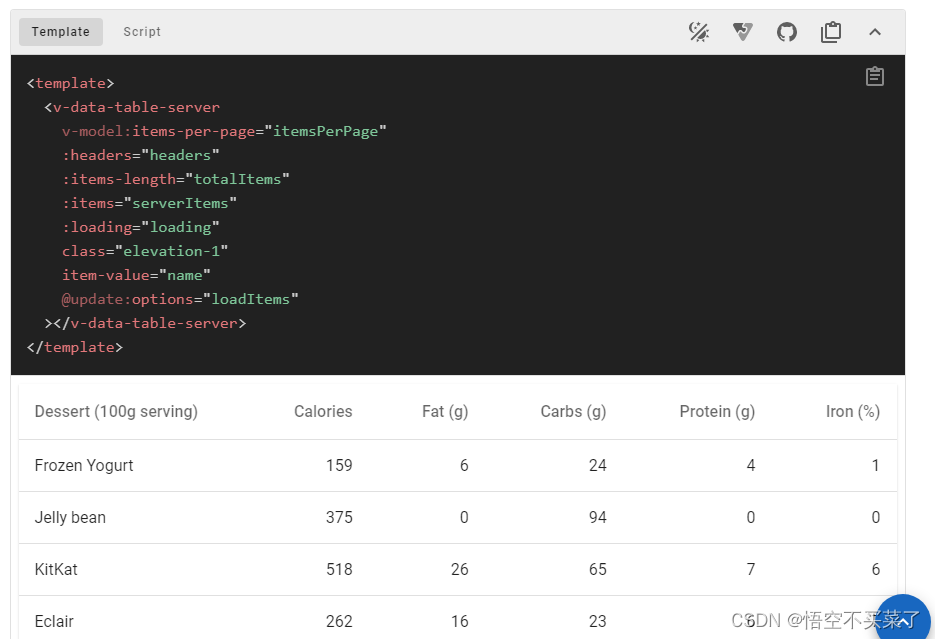 上面就是我们要用的模板代码
上面就是我们要用的模板代码
数据脚本当然是你在script里面,可以查看一下
<script>
const desserts = [
{
name: 'Frozen Yogurt',
calories: 159,
fat: 6.0,
carbs: 24,
protein: 4.0,
iron: '1',
},
{
name: 'Jelly bean',
calories: 375,
fat: 0.0,
carbs: 94,
protein: 0.0,
iron: '0',
},
{
name: 'KitKat',
calories: 518,
fat: 26.0,
carbs: 65,
protein: 7,
iron: '6',
},
{
name: 'Eclair',
calories: 262,
fat: 16.0,
carbs: 23,
protein: 6.0,
iron: '7',
},
{
name: 'Gingerbread',
calories: 356,
fat: 16.0,
carbs: 49,
protein: 3.9,
iron: '16',
},
{
name: 'Ice cream sandwich',
calories: 237,
fat: 9.0,
carbs: 37,
protein: 4.3,
iron: '1',
},
{
name: 'Lollipop',
calories: 392,
fat: 0.2,
carbs: 98,
protein: 0,
iron: '2',
},
{
name: 'Cupcake',
calories: 305,
fat: 3.7,
carbs: 67,
protein: 4.3,
iron: '8',
},
{
name: 'Honeycomb',
calories: 408,
fat: 3.2,
carbs: 87,
protein: 6.5,
iron: '45',
},
{
name: 'Donut',
calories: 452,
fat: 25.0,
carbs: 51,
protein: 4.9,
iron: '22',
},
]
const FakeAPI = {
async fetch ({ page, itemsPerPage, sortBy }) {
return new Promise(resolve => {
setTimeout(() => {
const start = (page - 1) * itemsPerPage
const end = start + itemsPerPage
const items = desserts.slice()
if (sortBy.length) {
const sortKey = sortBy[0].key
const sortOrder = sortBy[0].order
items.sort((a, b) => {
const aValue = a[sortKey]
const bValue = b[sortKey]
return sortOrder === 'desc' ? bValue - aValue : aValue - bValue
})
}
const paginated = items.slice(start, end)
resolve({ items: paginated, total: items.length })
}, 500)
})
},
}
export default {
data: () => ({
itemsPerPage: 5,
headers: [
{
title: 'Dessert (100g serving)',
align: 'start',
sortable: false,
key: 'name',
},
{ title: 'Calories', key: 'calories', align: 'end' },
{ title: 'Fat (g)', key: 'fat', align: 'end' },
{ title: 'Carbs (g)', key: 'carbs', align: 'end' },
{ title: 'Protein (g)', key: 'protein', align: 'end' },
{ title: 'Iron (%)', key: 'iron', align: 'end' },
],
serverItems: [],
loading: true,
totalItems: 0,
}),
methods: {
loadItems ({ page, itemsPerPage, sortBy }) {
this.loading = true
FakeAPI.fetch({ page, itemsPerPage, sortBy }).then(({ items, total }) => {
this.serverItems = items
this.totalItems = total
this.loading = false
})
},
},
}
</script>下面我们去看一下品牌表展示什么样的内容,我们看一下数据库里面的字段,先来创建一张产品表,然后把数据也给插入进去

下面我们把数据给插进去,类似于插入下面这些数据

看一下,很明显这个表的数据就已经存在了

我们表头我们直接可以从下面的位置修改

下面直接展示品牌页面前端所有代码
<template>
<v-card>
<v-card-title>
<v-btn color="primary" @click="addBrand">新增品牌</v-btn>
<!--搜索框,与search属性关联-->
<v-spacer/>
<v-flex xs3>
<v-text-field label="输入关键字搜索" v-model.lazy="search" append-icon="search" hide-details/>
</v-flex>
</v-card-title>
<v-divider/>
<v-data-table
:headers="headers"
:items="brands"
:pagination.sync="pagination"
:total-items="totalBrands"
:loading="loading"
class="elevation-1"
>
<template slot="items" slot-scope="props">
<td class="text-xs-center">{
{ props.item.id }}</td>
<td class="text-xs-center">{
{ props.item.name }}</td>
<td class="text-xs-center">
<img v-if="props.item.image" :src="props.item.image" width="130" height="40">
<span v-else>无</span>
</td>
<td class="text-xs-center">{
{ props.item.letter }}</td>
<td class="justify-center layout px-0">
<v-btn flat icon @click="editBrand(props.item)" color="info">
<i class="el-icon-edit"/>
</v-btn>
<v-btn flat icon @click="deleteBrand(props.item)" color="purple">
<i class="el-icon-delete"/>
</v-btn>
</td>
</template>
</v-data-table>
<!--弹出的对话框-->
<v-dialog max-width="500" v-model="show" persistent scrollable>
<v-card>
<!--对话框的标题-->
<v-toolbar dense dark color="primary">
<v-toolbar-title>{
{isEdit ? '修改' : '新增'}}品牌</v-toolbar-title>
<v-spacer/>
<!--关闭窗口的按钮-->
<v-btn icon @click="closeWindow"><v-icon>close</v-icon></v-btn>
</v-toolbar>
<!--对话框的内容,表单 这里是要把获得的brand 数据传递给子组件,使用自定义标签::oldBrand 而父组件值为oldBrand-->
<v-card-text class="px-5" style="height:400px">
<brand-form @close="closeWindow" :oldBrand="oldBrand" :isEdit="isEdit"/>
</v-card-text>
</v-card>
</v-dialog>
</v-card>
</template>
<script>
// 导入自定义的表单组件,引入子组件 brandform
import BrandForm from './BrandForm'
export default {
name: "brand",
data() {
return {
search: '', // 搜索过滤字段
totalBrands: 0, // 总条数
brands: [], // 当前页品牌数据
loading: true, // 是否在加载中
pagination: {}, // 分页信息
headers: [
{text: 'id', align: 'center', value: 'id'},
{text: '名称', align: 'center', sortable: false, value: 'name'},
{text: 'LOGO', align: 'center', sortable: false, value: 'image'},
{text: '首字母', align: 'center', value: 'letter', sortable: true,},
{text: '操作', align: 'center', value: 'id', sortable: false}
],
show: false,// 控制对话框的显示
oldBrand: {}, // 即将被编辑的品牌数据
isEdit: false, // 是否是编辑
}
},
mounted() { // 渲染后执行
// 查询数据--搜索后页面还处在第几页,只要搜索,页面渲染后重新查询
this.getDataFromServer();
},
watch: {
pagination: { // 监视pagination属性的变化
deep: true, // deep为true,会监视pagination的属性及属性中的对象属性变化
handler() {
// 变化后的回调函数,这里我们再次调用getDataFromServer即可
this.getDataFromServer();
}
},
search: { // 监视搜索字段
handler() {
this.pagination.page =1;
this.getDataFromServer();
}
}
},
methods: {
getDataFromServer() { // 从服务的加载数的方法。
// 发起请求
this.$http.get("/item/brand/page", {
params: {
key: this.search, // 搜索条件
page: this.pagination.page,// 当前页
rows: this.pagination.rowsPerPage,// 每页大小
sortBy: this.pagination.sortBy,// 排序字段
desc: this.pagination.descending// 是否降序
}
}).then(resp => { // 这里使用箭头函数
this.brands = resp.data.items;
this.totalBrands = resp.data.total;
// 完成赋值后,把加载状态赋值为false
this.loading = false;
//
})
},
addBrand() {
// 修改标记,新增前修改为false
this.isEdit = false;
// 控制弹窗可见:
this.show = true;
// 把oldBrand变为null,因为之前打开过修改窗口,oldBrand数据被带过来了,导致新增
this.oldBrand = null;
},
editBrand(oldBrand){
//test 使用
//this.show = true;
//获取要编辑的brand
//this.oldBrand = oldBrand;
//requestParam,相当于把http,url ?name=zhangsan&age=21 传给方法
//pathvarable 相当与把url www.emporium.com/1/2 传给方法
//如果不需要url上的参数controller不需要绑定数据
// 根据品牌信息查询商品分类, 因为前台页面请求是拼接的, data 类似于jquery 里面回显的数据
this.$http.get("/item/category/bid/" + oldBrand.id)
.then(({data}) => {
// 修改标记
this.isEdit = true;
// 控制弹窗可见:
this.show = true;
// 获取要编辑的brand
this.oldBrand = oldBrand
// 回显商品分类
this.oldBrand.categories = data;
})
},
closeWindow(){
// 重新加载数据
this.getDataFromServer();
// 关闭窗口
this.show = false;
}
},
components:{
BrandForm
}
}
</script>
<style scoped>
</style>

下面开始写后台逻辑

开始写后台,先写一个产品类
Brand.java
package com.leyou.item.pojo;
import lombok.Data;
import javax.persistence.GeneratedValue;
import javax.persistence.GenerationType;
import javax.persistence.Id;
import javax.persistence.Table;
/**
* Created by Administrator on 2023/9/2.
*/
@Data
@Table(name="tb_brand")
public class Brand {
@Id
@GeneratedValue(strategy= GenerationType.IDENTITY)
private Long id;
private String name;//品牌名称
private String image;//品牌图片
private Character letter;
}
接下来我们写上我们的通用Mapper类

下面我们去写service接口

下面去写Controller类
分析一下

返回的是什么:当前页的数据(list集合)和总条数
也就是上面返回的是如下一个分页对象,在ly-common模块里面,如果需要用到这个模块的对象,那么我们就需要把这个模块当成依赖引入到另外一个模块里面
这里是ly-item下面的模块ly-item-service需要用到PageResult对象

下面就是Controller中的代码
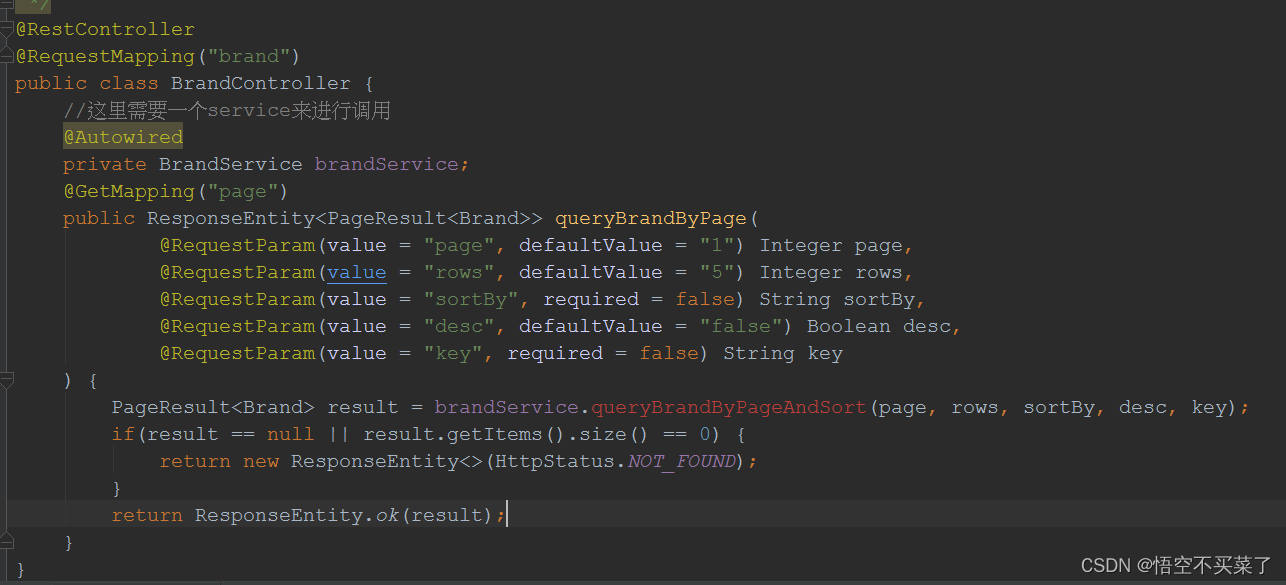
下面去完成Service中的方法
package com.leyou.item.service;
import com.github.pagehelper.Page;
import com.github.pagehelper.PageHelper;
import com.leyou.common.pojo.PageResult;
import com.leyou.item.mapper.BrandMapper;
import com.leyou.item.pojo.Brand;
import org.springframework.beans.factory.annotation.Autowired;
import org.springframework.stereotype.Service;
import tk.mybatis.mapper.entity.Example;
/**
* Created by Administrator on 2023/9/2.
*/
@Service
public class BrandService {
//内部需要一个mapper调用
@Autowired
private BrandMapper brandMapper;
/**
*
* @param page 当前页
* @param rows 每页大小
* @param sortBy 排序字段
* @param desc 是否降序
* @param key 搜索关键字
* @return
*/
public PageResult<Brand> queryBrandByPageAndSort(Integer page,Integer rows, String sortBy, Boolean desc, String key) {
//开启分页
//这个会自动拼接到后面的sql语句上面
PageHelper.startPage(page,rows);//传进来一个页码和展示多少行的数据,
//过滤
Example example = new Example(Brand.class);
if(key != null && !"".equals(key)) {
//进来有一模糊查询
//把这个语句拼接上
example.createCriteria().andLike("name","%" + key + "%").orEqualTo("letter",key);
}
if(sortBy != null && !"".equals(sortBy)) {
//根据sortBy字段进行排序
String orderByClause = sortBy + (desc ? " DESC " : " ASC ");
example.setOrderByClause(orderByClause);
}
//利用通用mapper进行查询
Page<Brand> pageInfo = (Page<Brand>) brandMapper.selectByExample(example);
//返回结果
//这里面传递总条数和页面信息
return new PageResult<>(pageInfo.getTotal(),pageInfo);
}
}
说一下,用Autowired注入Mapper的时候,提示注入不了,爆红
